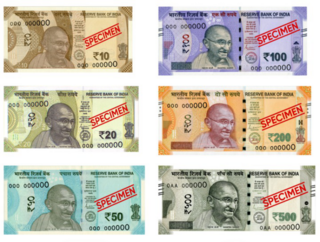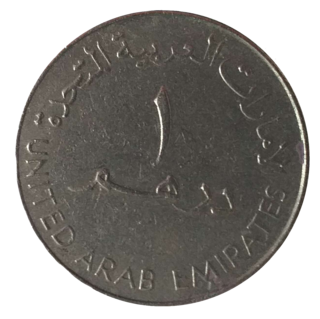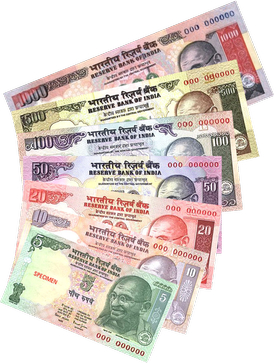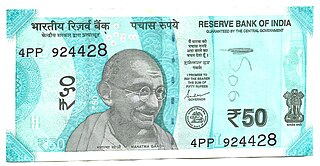
The Indian rupee is the official currency in India. The rupee is subdivided into 100 paise. The issuance of the currency is controlled by the Reserve Bank of India. The Reserve Bank manages currency in India and derives its role in currency management on the basis of the Reserve Bank of India Act, 1934.

The Mauritian rupee is the currency of Mauritius. One rupee is subdivided into 100 cents. Several other currencies are also called rupee.

The Pakistani rupee is the official currency in the Islamic Republic of Pakistan. The issuance of the currency is controlled by the State Bank of Pakistan. It was officially adopted by the Government of Pakistan in 1949. Earlier the coins and notes were issued and controlled by the Reserve Bank of India until 1949, when it was handed over to the Government and State Bank of Pakistan, by the Government and Reserve Bank of India.

The Arab Emirates Dirham (; Arabic: درهم إماراتي, abbreviation: د.إ in Arabic, Dh and Dhs or DH in Latin; ISO code: AED is the official currency of the United Arab Emirates. The dirham is subdivided into 100 fils . It is pegged to the United States Dollar at a constant exchange rate of approximately 3.67 AED to 1 USD.

Coins of the Indian rupee (₹) were first minted in 1950. New coins have been produced annually since then and they make up a valuable aspect of the Indian currency system. Today, circulating coins exist in denominations of One Rupee, Two Rupees, Five Rupees, Ten Rupees and Twenty Rupees. All of these are produced by four mints located across India, in Kolkata, Mumbai, Hyderabad, Noida.

The history of the rupee traces back to ancient times in the Indian subcontinent. The mention of rūpya by Pāṇini is seemingly the earliest reference in a text about coins. The term in Indian subcontinent was used for referring to a coin.
Fake Indian Currency Note (FICN) is a term used by officials and media to refer to counterfeit currency notes circulated in the Indian economy. In 2012, while responding to a question in parliament, the Finance Minister, P. Chidambaram, admitted that there is no confirmed estimate of fake currency in India. However, several central and state agencies are working together, and the Ministry of Home Affairs has constituted the Fake Indian Currency Notes Co-ordination Center (FCORD) to curb this menace.

The Gandhi Series of banknotes are issued by the Reserve Bank of India (RBI) as the legal tender of Indian rupee. The series is so called because the obverse of the banknotes prominently display the portrait of Mahatma Gandhi. Since its introduction in 1996, this series replaced all Lion Capital Series banknotes issued before 1996. The Reserve Bank of India (RBI) introduced the series in 1996 with ₹10 and ₹500 banknotes.

The Indian 1000-rupee banknote is an obsolete denomination of the Indian rupee. It was first introduced by the Reserve Bank of India in 1938 under British rule and subsequently demonetized in 1946. Post-independence, the denomination was re-introduced in 1954. In January 1978, all high-denomination banknotes of ₹1000,5000, and 10000 were demonetized in order to curb unaccounted cash money.

The Indian 100-rupee banknote is a denomination of the Indian rupee. It has been in continuous production since Reserve Bank of India took over the functions of the controller of currency in India in 1935. The present ₹100 banknote in circulation is a part of the Mahatma Gandhi New Series.

The is a denomination of the Indian rupee. The present ₹50 banknote in circulation is a part of the Mahatma Gandhi New Series of banknotes. However, ₹50 banknotes of the previous series will continue to be legal tender.

The Indian 20-rupee banknote is a common denomination of the Indian rupee. The current ₹20 banknote in circulation is a part of the Mahatma Gandhi New Series. The Reserve Bank introduced the ₹20 note in the Mahatma Gandhi New Series in 2019, making it the last denomination to be introduced in the series.

The Indian 10-rupee banknote is a common denomination of the Indian rupee. The ₹10 note was one of the first notes introduced by the Reserve Bank of India as a part of the Mahatma Gandhi Series in 1996. These notes are presently in circulation along with the Mahatma Gandhi New Series which were introduced in January 2018, this is used alongside the 10 rupee coin.

The 2000 rupee note was introduced by the Reserve Bank of India on 8 November 2016. The introduction of this denomination of the Indian rupee was part of the government's demonetization exercise aimed at curbing corruption, black money and counterfeit currency. On the same day, the Indian government announced the demonetization of the existing 500 rupee and 1000 rupee notes. The intention behind demonetization was to invalidate the old notes to disrupt illegal activities and promote a shift towards digital transactions.

On 8 November 2016, the Government of India announced the demonetisation of all ₹500 and ₹1,000 banknotes of the Mahatma Gandhi Series. It also announced the issuance of new ₹500 and ₹2,000 banknotes in exchange for the demonetised banknotes. Prime Minister Narendra Modi claimed that the action would curtail the shadow economy, increase cashless transactions and reduce the use of illicit and counterfeit cash to fund illegal activity and terrorism.

The Mahatma Gandhi New Series of banknotes are issued by the Reserve Bank of India (RBI) as the legal tender of the Indian rupee, intended to replace the Mahatma Gandhi Series of banknotes. Announced on 8 November 2016, it followed the demonetisation of ₹500 and ₹1000 banknotes of the original Mahatma Gandhi Series. Similar to the preceding series of banknotes, the obverse of the Mahatma Gandhi New Series banknotes also prominently displays the portrait of Mahatma Gandhi. The logo of Swachh Bharat Abhiyan is also printed on the back of the banknotes of this series.

The Indian 200-rupee note (₹200) is a denomination of the Indian rupee. After the 2016 Indian banknote demonetisation, the new currency notes were announced by the Reserve Bank of India: ₹2,000, ₹500, ₹200, ₹100, ₹50, ₹20 and ₹10.

The Indian 1-rupee note (₹1) is made up of hundred 100 paise as ₹1 = 100 paise. Currently, it is the smallest Indian banknote in circulation and the only one being issued by the Government of India, as all other banknotes in circulation are issued by the Reserve Bank of India. As a result, the one rupee note is the only note bearing the signature of the Finance Secretary and not the Governor of the RBI. Predominantly pinkish green paper is used during printing.

The Indian 5-rupee note is the second smallest Indian note in circulation. The Reserve Bank of India introduced the 5 rupee banknote as part of the Mahatma Gandhi Series in 1996. The printing of notes in the denominations of ₹5, however, has been discontinued as these denominations have been coinised but still these notes are valid legal tender in India.

The Lion Capital Series were a series of currency notes issued after India declared its independence from Great Britain and used until the Reserve Bank of India (RBI) introduced the Mahatma Gandhi Series in 1996 with banknotes in denominations of 10 and 500 rupees, and were designed with the image of the Lion Capital of Ashoka, the National Emblem which replaced the George VI banknote series. The first banknotes printed after India achieved its independence was a 1-rupee note.






















